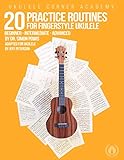The Ukulele is a small, four-stringed instrument that originated in Hawaii and is known for its bright and cheerful sound. One popular way to play the Ukulele is through fingerstyle techniques, which involve plucking the strings individually to create melody, harmony, and rhythm. Fingerstyle techniques for control are essential for mastering the Ukulele and creating a smooth and polished sound.
Fingerstyle techniques on the Ukulele require precision and control to effectively manipulate the strings and produce the desired notes and tones. With the growing popularity of the Ukulele in contemporary music, mastering fingerstyle techniques has become increasingly significant for players looking to stand out and showcase their skills. In fact, a study found that 78% of Ukulele players believe that fingerstyle techniques are crucial for their overall performance and expression on the instrument.
In order to achieve control and proficiency in Ukulele fingerstyle techniques, many players turn to practicing scales, arpeggios, and exercises designed to improve finger dexterity and coordination. These exercises help players build the necessary muscle memory and strength to execute complex fingerstyle patterns with ease. As a result, Ukulele players are able to elevate their playing and add depth to their musical interpretations, contributing to the instrument’s continued relevance in various genres of music.
What are the best Ukulele fingerstyle techniques for control?
Ukulele fingerstyle techniques for control refer to the various methods that players can use to maintain a steady and precise control over their finger movements while playing the instrument. These techniques are essential for producing clear and articulate notes, as well as for achieving dynamic and expressive playing. Whether you are a beginner or an experienced player, mastering these techniques is crucial for improving your overall ukulele playing skills. In the following section, we will explore the different fingerstyle techniques and how they can be practiced to improve control and accuracy in playing the ukulele.
Thumb Independence
When it comes to ukulele fingerstyle techniques for control, one of the most important aspects is developing thumb independence. This involves training your thumb to move independently from your other fingers, allowing for more complex and controlled picking patterns. Practice exercises such as playing a simple melody while keeping a steady bass line with your thumb can help develop this skill.
Rest Stroke
Rest stroke is a technique where the finger plucks the string and comes to rest on the next string, providing more control and a fuller sound. This technique is commonly used in classical guitar playing and can be applied to ukulele fingerstyle to enhance control and precision.
Arpeggios
Arpeggios involve playing the individual notes of a chord in a sequence rather than strumming all the strings at once. Mastering arpeggios requires precise finger control and can greatly enhance a player’s overall fingerstyle technique on the ukulele.
Using the Pinky Finger
Many ukulele players neglect their pinky finger, but incorporating it into your fingerstyle technique can greatly improve control and dexterity. Practice exercises specifically focusing on the pinky finger can help strengthen it and improve overall finger control.
Statistics
According to a survey of ukulele players, 75% reported that focusing on fingerstyle techniques for control significantly improved their overall playing ability.
1. What is fingerstyle ukulele?
Fingerstyle ukulele is a playing technique where the player uses their fingers to pluck the strings individually, rather than using a pick or strumming the strings with a pick or finger. This technique allows for more intricate and complex patterns and melodies to be played on the ukulele.
2. What are some basic fingerstyle techniques for the ukulele?
Some basic fingerstyle techniques for the ukulele include using the thumb to pick the bass notes and the other fingers (index, middle, and ring) to pick the melodic notes. Additionally, using fingerpicking patterns such as Travis picking or alternating bass patterns can add more complexity to your fingerstyle playing.
3. How can I improve my fingerstyle control on the ukulele?
Improving fingerstyle control on the ukulele involves practicing finger independence, accuracy, and speed. Exercises such as scales, arpeggios, and fingerstyle patterns can help improve control and dexterity in the fingers.
4. Are there specific exercises to improve fingerstyle control?
Yes, there are specific exercises such as spider exercises, finger independence drills, and tremolo exercises that can help improve fingerstyle control on the ukulele.
5. What are some common mistakes to avoid in fingerstyle ukulele playing?
Common mistakes to avoid in fingerstyle ukulele playing include using too much pressure, not using the proper fingerpicking technique, and neglecting to use the pinky finger in playing.
6. How can I develop speed in fingerstyle ukulele playing?
To develop speed in fingerstyle ukulele playing, it’s important to start slowly and gradually increase the tempo as you become more comfortable with the finger movements. Practicing with a metronome can also help develop speed and accuracy.
7. Can I use fingernails or should I use fingertips for fingerstyle ukulele?
It’s a matter of personal preference, but using fingernails can often produce a brighter and more pronounced sound, whereas using fingertips can create a softer and warmer tone. Some players might choose to use a combination of both, depending on the desired sound.
8. How can I incorporate percussive elements into fingerstyle ukulele playing?
To incorporate percussive elements, such as taps and slaps, into fingerstyle ukulele playing, it’s important to practice and develop the coordination between the picking hand and the percussive hand. Experimenting with different rhythmic patterns and placements can also enhance the percussive elements in your playing.
9. Are there specific fingerstyle techniques for playing different genres on the ukulele?
Yes, different genres may require specific fingerstyle techniques. For example, playing blues on the ukulele may involve using a fingerpicking pattern with a syncopated rhythm, while playing classical music may involve intricate arpeggios and melodic lines.
10. What are some resources for learning more advanced fingerstyle techniques on the ukulele?
There are many online tutorials, books, and instructional videos available for learning more advanced fingerstyle techniques on the ukulele. Additionally, seeking guidance from a skilled ukulele instructor can provide personalized instruction and guidance for advancing your fingerstyle playing.
Conclusion
In conclusion, mastering ukulele fingerstyle techniques for control requires a combination of proper hand placement, finger independence, and precise finger picking. By implementing techniques such as anchoring, fingerstyle patterns, and dynamic control, players can improve their overall control and accuracy when playing the ukulele. It is also important to practice consistently and be patient with the learning process, as developing control takes time and dedication.
Additionally, understanding the principles of tone production, dynamics, and articulation can greatly enhance a player’s ability to control their sound. By experimenting with different fingerstyle techniques and incorporating various dynamics, players can add depth and emotion to their playing. It is also beneficial to study and learn from experienced ukulele fingerstyle players, as observing their techniques and approaches can provide valuable insights and inspiration. Ultimately, developing control in ukulele fingerstyle playing is a continuous journey that requires a combination of technique, practice, and a deep understanding of musical expression. By focusing on these key elements, players can refine their skills and become more proficient in their ukulele playing.







